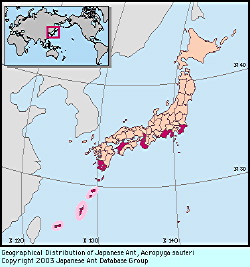
|
species
|
Acropyga sauteri
|
 |
Japanese Name
|
Mitsuba-ari
|
Original Reference
|
|
Forel, A. (1912) H. Sauter's Formosa-Ausbeute: Formicidae. Entomologische Mitteilungen 1: 45-81.
|
Description
|
|
Total length of workers around 2-2.5 mm. Body color yellow. Head almost square in full face view; mandibles with 3 well-developed teeth. Antennae 11-segmented; scape reaching posterior margin of head. Eyes minute, each a single facet. Promesonotum gently convex and propodeum convex in profile. Mesosoma with numerous short erect dorsal hairs.
|
Remarks
|
|
This species is assigned to Acropyga subgenus Rhizomyrma. The symbiont mealy bug Eumyrmococcus smithi is tended in its nests. Nuptial flights may be observed from late March to June. Each alate female leaves the parent nest with a gravid female Eumyrmococcus in her mandibles (Uye, 1928, 1933; Teranishi, 1929). A. sauteri is found in grasslands or at the margins of woods. It nests under stones or directly in the soil.
|
|

Distribution
|
|
Honshu (southern part), Shikoku, Kyushu, Nansei Is; Mainland China (southern part), Taiwan.
|
|
References
|
|
- Uye, T. (1928). Arinotakara: a coccid, the treasure of the ant. Insects World, 32, 77-79.
- Uye, T. (1933). A stock raising ant. . Entomological World, 1, 602-608. .
- Teranishi, C. (1929a. ). Japanese ants, their behavior and distribution (I). . Zool. Mag. Tokyo, 41, 239-251. .
- H. Sauter's Formosa-Ausbeute: Formicidae. Entomologische Mitteilungen 1: 45-81.
|
Editor
|
|
Original text by Mamoru Terayama and Masao Kubota. English translation by Mamoru Terayama, edited by Robert W. Taylor.
|
|